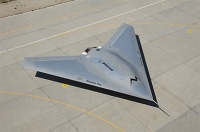The 17-minute flight took place following a series of high-speed taxi tests in March that validated ground guidance, navigation and control, and verified mission planning, the pilot interface and operational procedures.
Phantom Ray flew to 7,500ft and reached a speed of 178 knots, demonstrating the aircraft’s basic airworthiness and setting the stage for additional flights in the next few weeks.
The company-funded flights will prepare Phantom Ray to support potential missions that may include intelligence, surveillance and reconnaissance, suppression of enemy air defences, electronic attack, strike and autonomous air refuelling.
Phantom Ray is one of several programmes in Phantom Works, including Phantom Eye, which is part of a rapid prototyping initiative to design, develop and build advanced aircraft and then demonstrate their capabilities.

Boeing’s portfolio of unmanned airborne systems also includes the A160T Hummingbird, Integrator, ScanEagle and SolarEagle.




Nanogenerator consumes CO2 to generate electricity
Nice to see my my views being backed up by no less a figure than Sabine Hossenfelder https://youtu.be/QoJzs4fA4fo